3.4: Bronze Age- Western Zhou Dynasty (1046 BCE – 771 BCE)
- Page ID
- 219967
\( \newcommand{\vecs}[1]{\overset { \scriptstyle \rightharpoonup} {\mathbf{#1}} } \)
\( \newcommand{\vecd}[1]{\overset{-\!-\!\rightharpoonup}{\vphantom{a}\smash {#1}}} \)
\( \newcommand{\id}{\mathrm{id}}\) \( \newcommand{\Span}{\mathrm{span}}\)
( \newcommand{\kernel}{\mathrm{null}\,}\) \( \newcommand{\range}{\mathrm{range}\,}\)
\( \newcommand{\RealPart}{\mathrm{Re}}\) \( \newcommand{\ImaginaryPart}{\mathrm{Im}}\)
\( \newcommand{\Argument}{\mathrm{Arg}}\) \( \newcommand{\norm}[1]{\| #1 \|}\)
\( \newcommand{\inner}[2]{\langle #1, #2 \rangle}\)
\( \newcommand{\Span}{\mathrm{span}}\)
\( \newcommand{\id}{\mathrm{id}}\)
\( \newcommand{\Span}{\mathrm{span}}\)
\( \newcommand{\kernel}{\mathrm{null}\,}\)
\( \newcommand{\range}{\mathrm{range}\,}\)
\( \newcommand{\RealPart}{\mathrm{Re}}\)
\( \newcommand{\ImaginaryPart}{\mathrm{Im}}\)
\( \newcommand{\Argument}{\mathrm{Arg}}\)
\( \newcommand{\norm}[1]{\| #1 \|}\)
\( \newcommand{\inner}[2]{\langle #1, #2 \rangle}\)
\( \newcommand{\Span}{\mathrm{span}}\) \( \newcommand{\AA}{\unicode[.8,0]{x212B}}\)
\( \newcommand{\vectorA}[1]{\vec{#1}} % arrow\)
\( \newcommand{\vectorAt}[1]{\vec{\text{#1}}} % arrow\)
\( \newcommand{\vectorB}[1]{\overset { \scriptstyle \rightharpoonup} {\mathbf{#1}} } \)
\( \newcommand{\vectorC}[1]{\textbf{#1}} \)
\( \newcommand{\vectorD}[1]{\overrightarrow{#1}} \)
\( \newcommand{\vectorDt}[1]{\overrightarrow{\text{#1}}} \)
\( \newcommand{\vectE}[1]{\overset{-\!-\!\rightharpoonup}{\vphantom{a}\smash{\mathbf {#1}}}} \)
\( \newcommand{\vecs}[1]{\overset { \scriptstyle \rightharpoonup} {\mathbf{#1}} } \)
\( \newcommand{\vecd}[1]{\overset{-\!-\!\rightharpoonup}{\vphantom{a}\smash {#1}}} \)
Introduction
The Shang dynasty saw great prosperity until the ninth emperor, after which corruption and unrest plagued the country. The final Shang emperor lived in luxury and tortured the people, ultimately dividing the nobility. The Zhou dynasty, formerly an ally of the Shang, rose under King Wu's leadership and united the people and surrounding tribes. Wu's triumph led to the establishment of the Western Zhou dynasty, which endured from 1046 to 771 BCE. Ma Lin, a painter from the Song era, captured Wu's likeness on silk (3.4.1) alongside the images of three other early emperors. Wu's reign was cut short, but his son continued the dynasty's growth and expansion. The Zhou rulers believed in the Mandate of Heaven, a divine source that granted them the right to rule. However, they recognized that this power came with a responsibility to serve their subjects for the greater good, lest great misfortune befall their people.
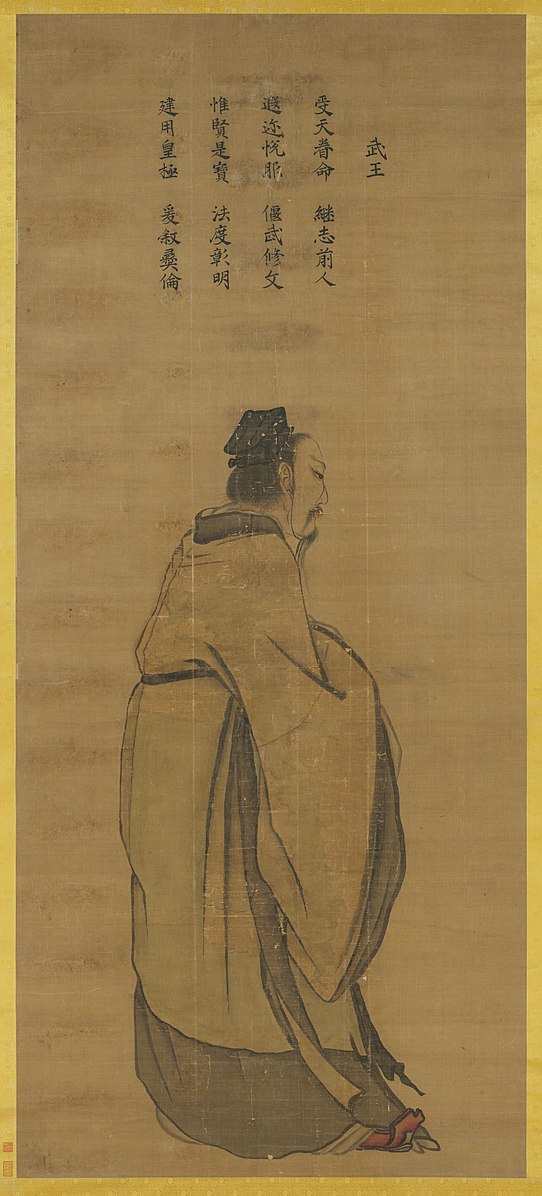
In the Zhou dynasty, forming regional states was pivotal in establishing the dynasty. This political system effectively united multiple factions and gave them territories to govern. However, this system also resulted in internal conflicts within the states, ultimately contributing to the dynasty's downfall. Throughout its existence, the Zhou dynasty was governed by thirteen emperors who presided while significant changes occurred. These emperors implemented rigorous regulations for ceremonies, including a ban on alcohol consumption, indicating their disapproval of this custom during the previous Shang dynasty.
The roots of agricultural science can be traced back to a bustling region inhabited by more than 13 million people. Inventive tools were devised to enable intensive farming and sustain the rapidly growing population. The fields were partitioned into thirds, with one-third reserved for regeneration, and a methodical technique was employed to cultivate an array of crops. These breakthroughs had practical benefits and contributed significantly to divination, reducing reliance on oracle bones. The creation of innovative tools and weaponry, aided by the production of bronze ware, further propelled society's advancement. The region's agricultural and metallurgical approaches were pivotal to economic and social development.
Architecture
The majestic temples and opulent palaces of the three powerful dynasties were erected in bustling cities, serving as a testament to their grandeur and influence. As the Zhou dynasty came into power, they implemented a system dividing the kingdom into states. In the process of excavating the remains of the buildings erected in the capitals by the local chieftains, the foundations were revealed, providing a glimpse into the architectural marvels of a bygone era.
"Palaces – the architectural symbols of royal power – offer fascinating details about early Chinese architecture. Some of the earliest foundations of palace remains have been excavated…. Each palace had a main building that was enclosed by a covered arcade and oriented almost exactly north–south. Wall raised on pounded–earth foundations and supported by wooden columns and beams are believed to have been smeared with mud, and it seems that roofs were thatched. One of the palaces was eight bays across the front, the center six of which appear to have been open to the outside. The entire building was enclosed by a covered arcade made of wood with a tile roof, a prototype of the covered corridors connecting almost every Chinese building complex in later times. Possibly the even number of bays across the front of the main hall (defined by the pillar holes) was symbolically important in Three Dynasties society."[1]
Historically, emperors had established guidelines for architectural residences belonging to different social classes. Notably, red pillars were exclusively reserved for emperors, while black pillars denoted homes of the wealthy, and yellow pillars were used for the middle class. However, those from lower socio-economic backgrounds did not have pillars and opted instead for whitewashed homes. Recent archaeological excavations have uncovered foundation outlines and post holes for pillars in other structures on the property. Furthermore, researchers have discovered indications of protective structures such as gates and walls and sophisticated drainage systems.
During the reign of the three dynasties, ritual sacrifices were a prevalent tradition during the era of the three dynasties. The palaces constructed altars for this purpose, and archeological evidence, such as animal remains, pottery, stone, jade, and bronze artifacts, have been unearthed. During the Shang period, human and animal sacrifices were performed at specific times, while the Zhou dynasty witnessed a decline in human sacrifices. Instead, royal tombs were adorned with spirit objects, typically ceramic figurines crafted to honor the ancestors.
In ancient China, specifically during the Shang and early Zhou dynasties, tombs were constructed to honor the deceased. These tombs were filled with the belongings of the departed, including chariots, horses, and weapons. In some cases, enslaved people were also coerced into taking their own lives or were killed to be buried alongside their masters. It was believed that the dead would continue to exist in the tombs and required their possessions to accompany them to the afterlife. It's been suggested that individuals of this era believed that retaining their luxurious lifestyle was possible even in the spiritual realm if they brought their possessions.
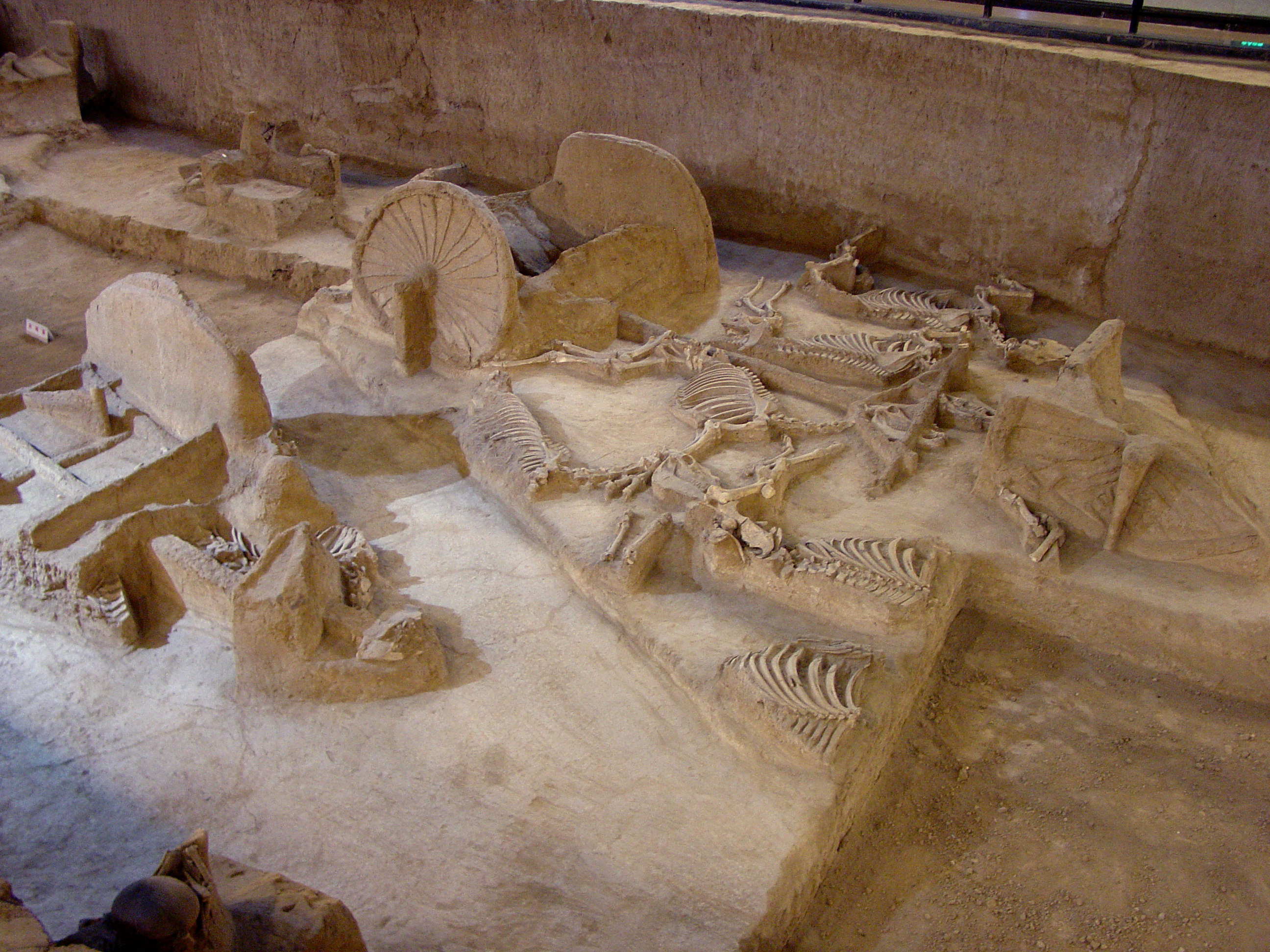
1956, a remarkable discovery was made at the Western Zhou Chariot Burial Pit. Deep pits, about two meters in depth, revealed an ancient record of the people. The excavation unearthed wooden chariots (3.4.2) with single shafts used in battles and pulled by four horses. These chariots were exquisitely decorated with bronze and possibly painted with colorful lacquer. A dog's skeleton (3.4.3) was found in one chariot used for transporting goods, while horses were typically killed and arranged in the tomb. One chariot featured six horses highly adorned with silver, and another had a human skeleton inside, who could have been the wagon driver. Moreover, numerous bronze vessels and weapons (3.4.4) were discovered in large pits. The quantity and quality of chariots, horses, enslaved people, bronze, and other ornamentation indicated the owner's relative wealth. The artifacts showcased the skill and proficiency of the art of bronze, leather, jade, pottery, and woodworking during this era.
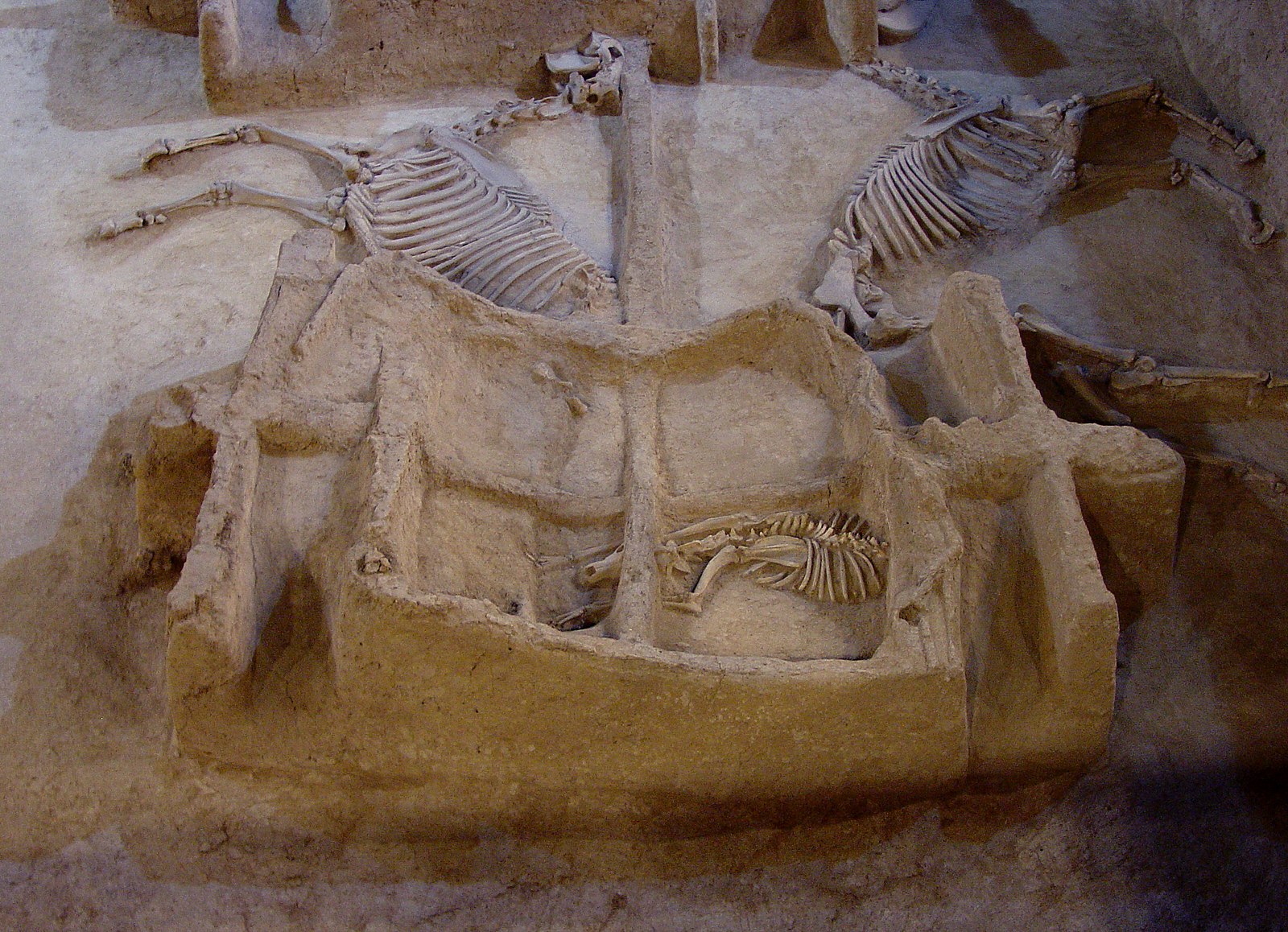

Art
During the Zhou era, bronze artistry reached new heights as animal depictions became increasingly abstract and Shang designs evolved into more fluid and open styles. The use of bronze vessels as symbols of power and for ancestor worship and ceremonial purposes began in the Xia period, continued through the Shang, and persisted into the Zhou dynasty. While wine vessels were the most common during the Shang era, the Zhou dynasty disapproved of drunkenness. It produced fewer wine vessels and concentrated on developing innovative styles of vessels for storage and cooking.
During the Zhou period, the bronze age reached its peak. The intricate and detailed designs of a ritual set of bonzes (3.4.5), which includes several vessels of different sizes and an altar table, showcase the remarkable artistic talent of the era's creators. The larger vessels boast unique projections made possible only through Zhou's advanced casting process, which involved building foundries in multiple locations. In contrast to the Shang period, the Zhou utilized linear and curvilinear lines instead of animal-like figures in their designs. One vessel (3.4.6) demonstrates horizontal fluting, with only the handles featuring animal motifs. The lid is inscribed: "The Earl of San made this precious gui for Ji of Zhe. May it be perpetually used for tens and thousands of years."[2] It was likely intended for burial in the owner's tomb, as its use was expected to extend far beyond a typical lifespan.

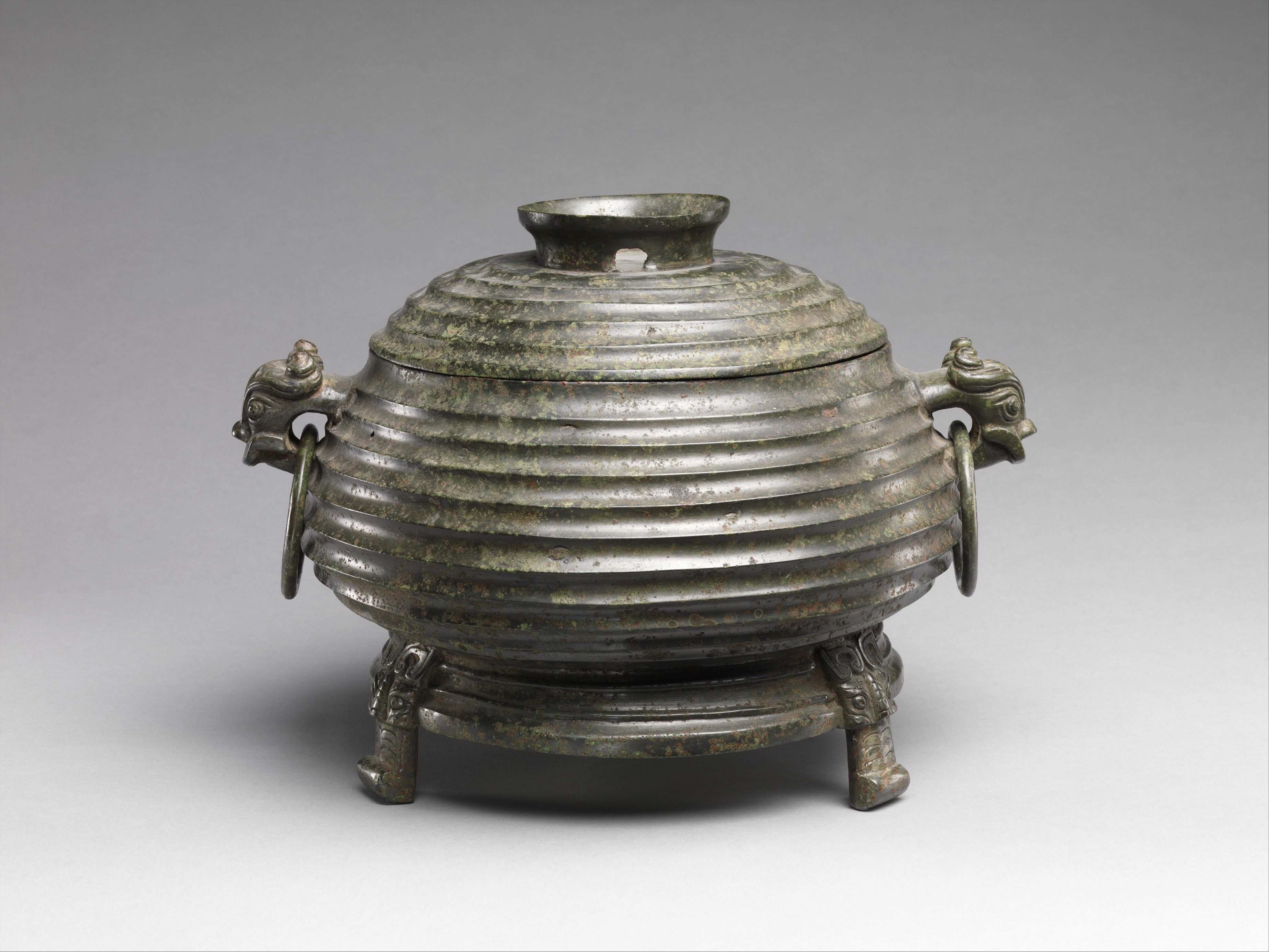
Watch Dr. Tao Wang, Senior Vice President and Head of the Chinese Works of Art department, as he discusses the function and the taotie decorative motifs of ritual bronzes from the collection of Julius Eberhardt, featured in the sale of Magnificent Ritual Bronzes. Dr. Wang explains how ritual bronze vessels -- including the Zuo Bao Yi Gui, a two-handled bronze vessel -- were used for ancestor veneration during the Chinese Bronze Age.
Jade Evolution
Throughout the three dynasties, jade was a highly sought-after material amongst artists. Two distinct minerals fall under the category of jade: nephrite and jadeite. Nephrite is composed of several minerals, including iron, calcium, and magnesium, while jadeite is a type of pyroxene. Nephrite jade is available in various colors, including brown, white, gray, green, and yellow, and can be translucent. This type of jade was the most commonly used material among artists during the era, although it was primarily reserved for ceremonial objects and considered the imperial gem. Even though jade objects could be practical, their primary purpose was to be used for ceremonial purposes.
An exploration of the significance and working of jade in China.
Jade was a common ceremonial item throughout the Shang and Zhou dynasties. Jade items were frequently buried with the dead to add to the person's celestial journey. The pale green item was carved with elaborate designs of birds and masks, probably used as a ceremonial scepter (3.4.7). Made from nephrite jade, the necklace (3.4.8) demonstrates the abilities and skills an artisan had to create the necklace. The thin, delicate quarter circles hang from different parts, tied together with small beads. Jade was very hard and not easy to carve. People used abrasion with sand pastes to wear away pieces of jade, and because it was so hard to work with, jade became a symbol of the ruling class.
During the Zhou dynasty, jade was significant as representing power, wealth, and status. It was frequently utilized to craft items for the departed to aid them in their journey to the afterlife. The Jade Composite Sculpture of a Human Bust, Birds, and Taotie Mask (3.4.9) is a captivating composite image fashioned from beautifully polished gray-green jade with a mottled appearance. It showcases a human bust at its center that boasts intricately crafted features such as small, incised eyes, smooth raised eyebrows, a pouting mouth, and large pierced ears. The head tapers towards the top, culminating in a deep drill-hole. The figure has sloping shoulders, and a rectangular jewel adorns the throat. The hair is visible only at the back and is evenly striated, ending in a small curl. On the left and right sides of the neck, there are rows of three widely spaced small dots in relief, with a large, round button located directly beneath them. This button boasts a circular depression in the center and a partly fractured edge.
The depicted figure lacks arms, but instead features two birds facing outward. These birds possess long, scaly necks, short crests, hammer-shaped beaks, stubby wings, and animalistic claws. These details are mirrored on the opposite side of the figure. A Taotie Mask with convoluted horns and pointed ears sits between the birds, covering a wide opening that protrudes downward. Lateral perforations on the socket wall, just below the level of the birds, enable the finial to be securely fastened to a staff. When viewed from underneath, the object resembles a segment, with the back forming the perimeter.

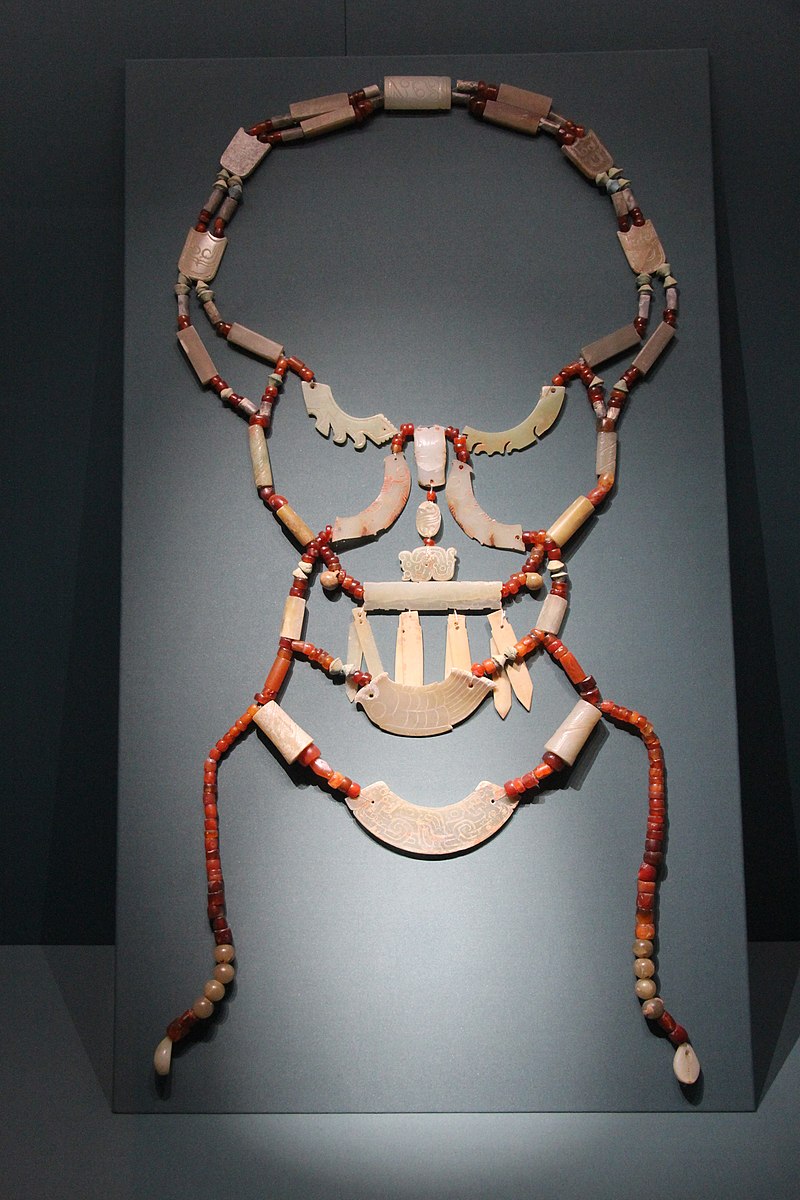
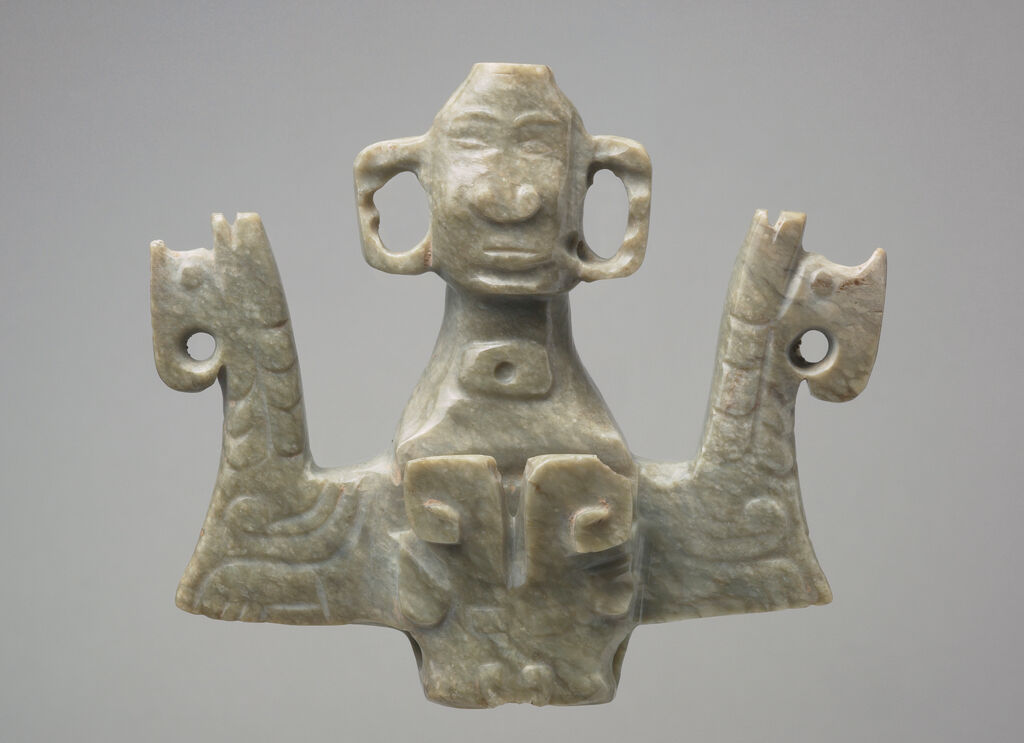
Written Language
The use of 'bronze script' during the Shang and Zhou dynasties to incise wet clay molds with a stylus before casting bronze was a widespread practice. The process involved skilled artisans using a sharp stylus to carve the text onto the mold, which would then be filled with molten bronze. This technique allowed for detailed, intricate designs to be created on the final product, giving it a unique and artistic touch. However, as time passed, engraving inscriptions onto the bronze after casting became more prevalent in later dynasties. This technique involved carving the text onto the solid bronze using various tools, which allowed for a more refined and polished finish.
"The Chinese characters inscribed in Western Zhou dynasty… bronze basically continued from the Shang writing system without radical or sudden change. They were like their Shang predecessors in all media, often irregular in shape and size, and the structures and details often varied from one piece of writing to the next, even within the same piece. During the Western Zhou, many graphs began "to show signs of simplification and linearization – the changing of rounded elements into squared ones, solid elements into short line segments, and thick, variable-width lines into thin ones of uniform width."[3]
The evolution and transfiguration of the word for tiger (3.4.10) demonstrated the process from pictorial to abstract symbol. The word hu first appeared in the Shang inscription as a picture of a tiger, complete with a head, a pair of eyes, a body, four legs, colorful fur, and a tail. It lost its head (which was replaced by a triangle) in the early oracle bone inscriptions. In later Shang, the body disappeared and was replaced by a vertical stroke. In middle Zhou inscriptions, especially those in bronze, the stripes and fur completely disappeared and were simplified into a stroke."[4] The Shang bronze script dates back to the 16th century BCE and provides a more realistic and detailed representation of a tiger than later Shang and Zhou characters. These later characters demonstrate the evolution and changes over time, leading to the modern form of the word. Observing the character's gradual transformation and its simplification over time is fascinating.
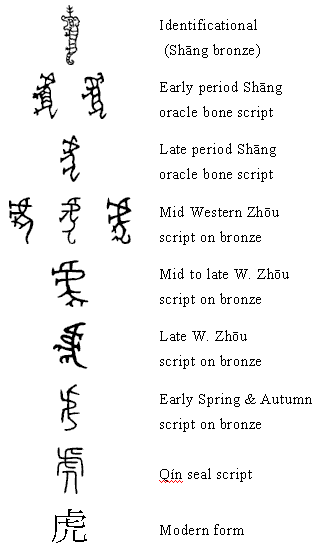
A fascinating discovery has been made in the form of a bronze script rubbing (3.4.11) that sheds light on the meticulous work of Song, a hardworking warehouse supervisor. This script contains detailed information about the various appointments made by Song and, interestingly, has been observed on multiple vessels, suggesting that Song reviewed and approved every single item with utmost care. The text is so precise that it can be traced back to the third year of the king's reign, which is believed to be 825 BCE. This discovery provides a valuable glimpse into the everyday life of ancient China, highlighting the importance of record-keeping and attention to detail in this era.
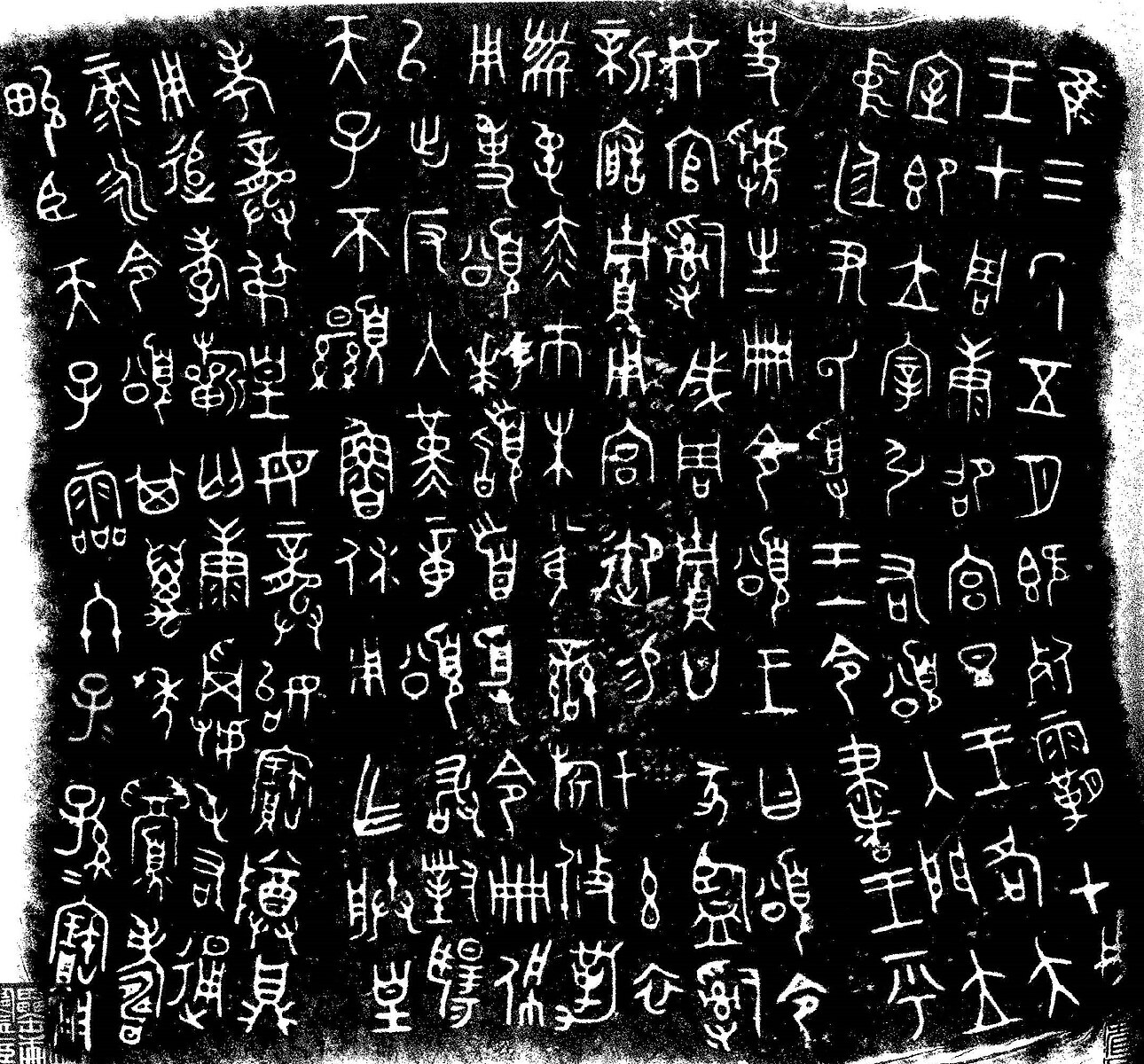
[1] Fu, X. (2002). Chinese Architecture. Yale University Press. (p. 25).
[2] Retrieved from: https://www.metmuseum.org/art/collection/search/44514
[3] Retrieved from https://wiki.alquds.edu/?query=Chine...e_inscriptions
[4] Gu, S. (2011). A cultural history of the Chinese language. McFarland. (p. 40).


